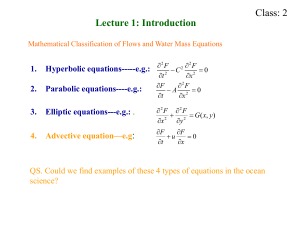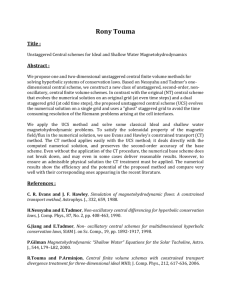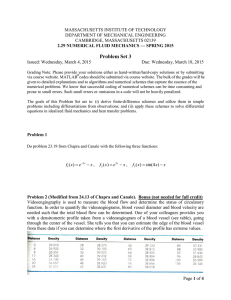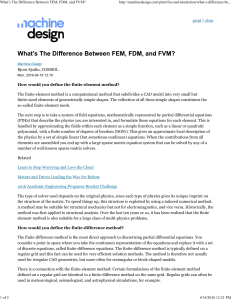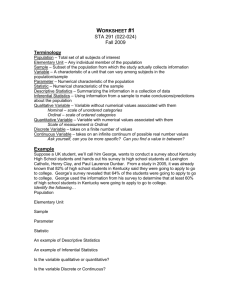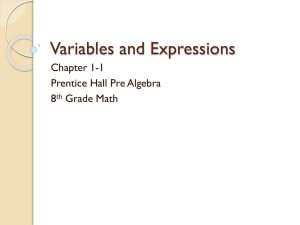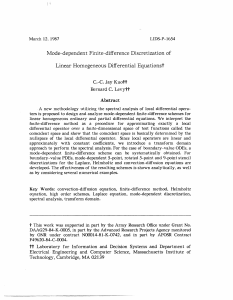MAR 665: Numerical Methods in Ocean Sciences
advertisement
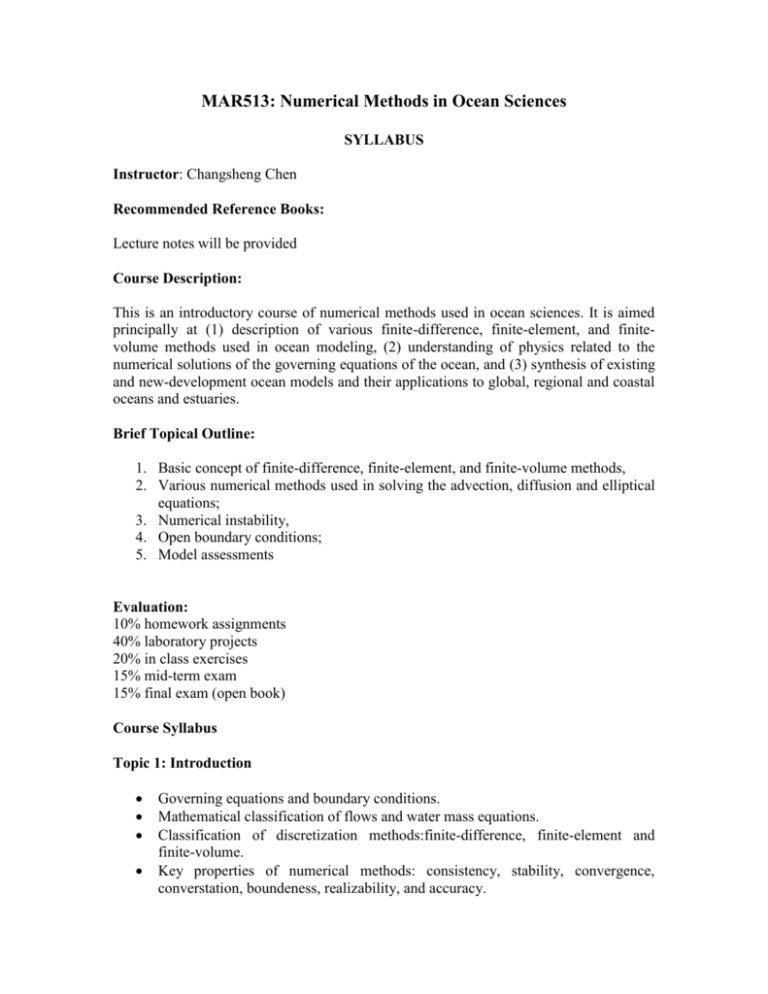
MAR513: Numerical Methods in Ocean Sciences SYLLABUS Instructor: Changsheng Chen Recommended Reference Books: Lecture notes will be provided Course Description: This is an introductory course of numerical methods used in ocean sciences. It is aimed principally at (1) description of various finite-difference, finite-element, and finitevolume methods used in ocean modeling, (2) understanding of physics related to the numerical solutions of the governing equations of the ocean, and (3) synthesis of existing and new-development ocean models and their applications to global, regional and coastal oceans and estuaries. Brief Topical Outline: 1. Basic concept of finite-difference, finite-element, and finite-volume methods, 2. Various numerical methods used in solving the advection, diffusion and elliptical equations; 3. Numerical instability, 4. Open boundary conditions; 5. Model assessments Evaluation: 10% homework assignments 40% laboratory projects 20% in class exercises 15% mid-term exam 15% final exam (open book) Course Syllabus Topic 1: Introduction Governing equations and boundary conditions. Mathematical classification of flows and water mass equations. Classification of discretization methods:finite-difference, finite-element and finite-volume. Key properties of numerical methods: consistency, stability, convergence, converstation, boundeness, realizability, and accuracy. Topic 2: Finite-Difference Methods Taylor series expansions and order of approximation Explicit and implicit discretizations Forward, backward, and central difference schemes Leapfrog scheme, Euler scheme, upwind/downwind time/implicit central space scheme, Crank-Nicolson Scheme and Lax-Wendroff scheme schemes, forward Topic 3: Numerical Stability Definition Algorithms for linear stability Stability analysis of popular finite-difference schemes. Computational dispersions and numerical oscillations Algorithms for nonlinear stability Topic 4: Finite-Difference Methods for Multi-Variable Equations One-dimensional gravity waves Two-dimensional advection problems-staggered grid approach Two-dimensional gravity waves-Arakawa-A, B, C, D and E grids Gravity-inertial wave problems-numerical dispersion and phase plan. Topic 5: Solid and Open Boundaries Slip and no-slip conditions for steady and unsteady flows Periodic open boundary conditions No flux or no gradient open boundary conditions Radiation boundary conditions-CLP, GRD, GWE, GWI, PCE, PCI, ORE and ORI Moving boundary conditions Sponge layers Topic 6: Finite-Volume Methods Structured grid finite-volume methods-first and second order flux schemes Two-dimensional flux methods-higher-order approximate schemes Unstructured grid finite-volume methods-cell-centered, cell-vertex overlapped and cell-vertex median Staggered unstructured grid schemes Wet/dry treatments in structured and unstructured grid schemes Comparison between finite-difference and finite-volume methods Popular structured and unstructured grid finite-volume models Topic 7: Data assimilations General concepts Nudging methods Optimal Interpolation methods Adjoint methods (linear and nonlinear system) Reduced Kalman filter Ensemble Kalman filter Ensemble square root Kalman filter Ensemble transform Kalman filter Limitation of data assimilation-perturbation theory Dynamics via assimilation Topic 8: Non-hydrostatic Discretization Projection methods Pressure correction methods Accuracy and Mass conservation Algorithm validation Topic 9: Multi-domain Numerical Computations One-way nesting Two-way nesting Topic 10: Numerical Errors in Terrain-Following Coordinate Models Causes of pressure errors due to coordinate transformation Pressure error estimation Possible solutions or approaches to reduce the errors Topic 11: Surface Wave Modeling Dynamics of the high-frequency surface waves in the ocean Spectrum density equation for the surface waves Common discrete methods to resolve the surface wave equation Applications and validations Topic 12: Current-Wave-Sediment Coupling A state-of-the art approach for coupling Critical issues related to coupling Topic 13: Ecosystem Modeling Concepts of an ecosystem model Residence time Simple NP and NPZ models
